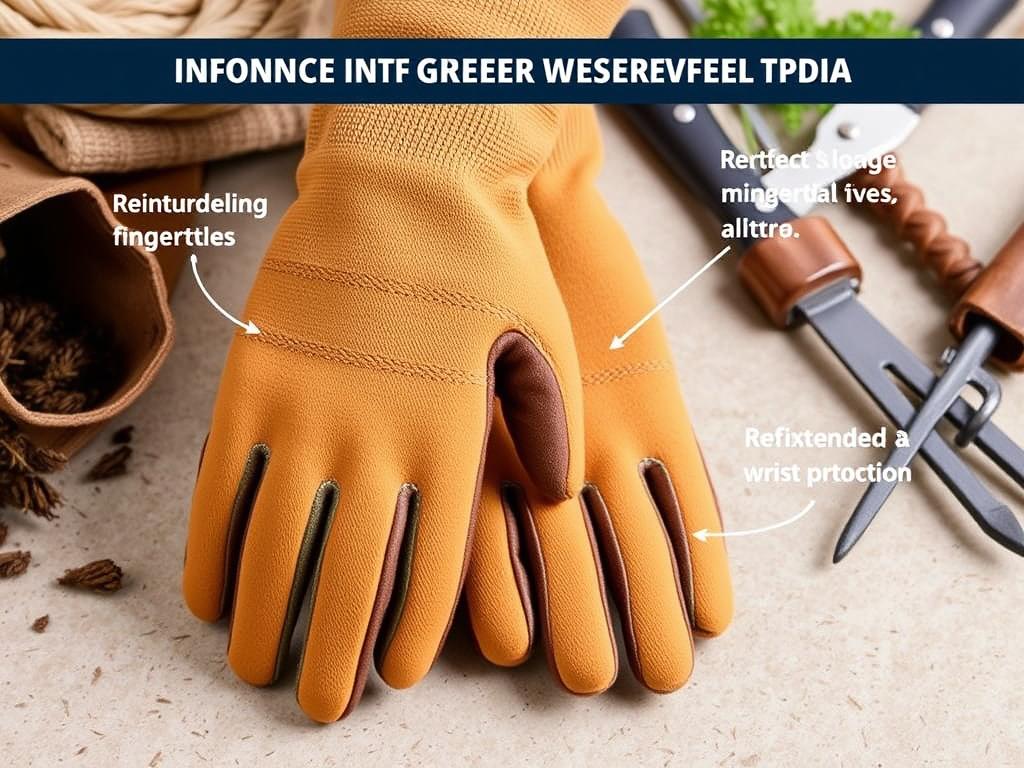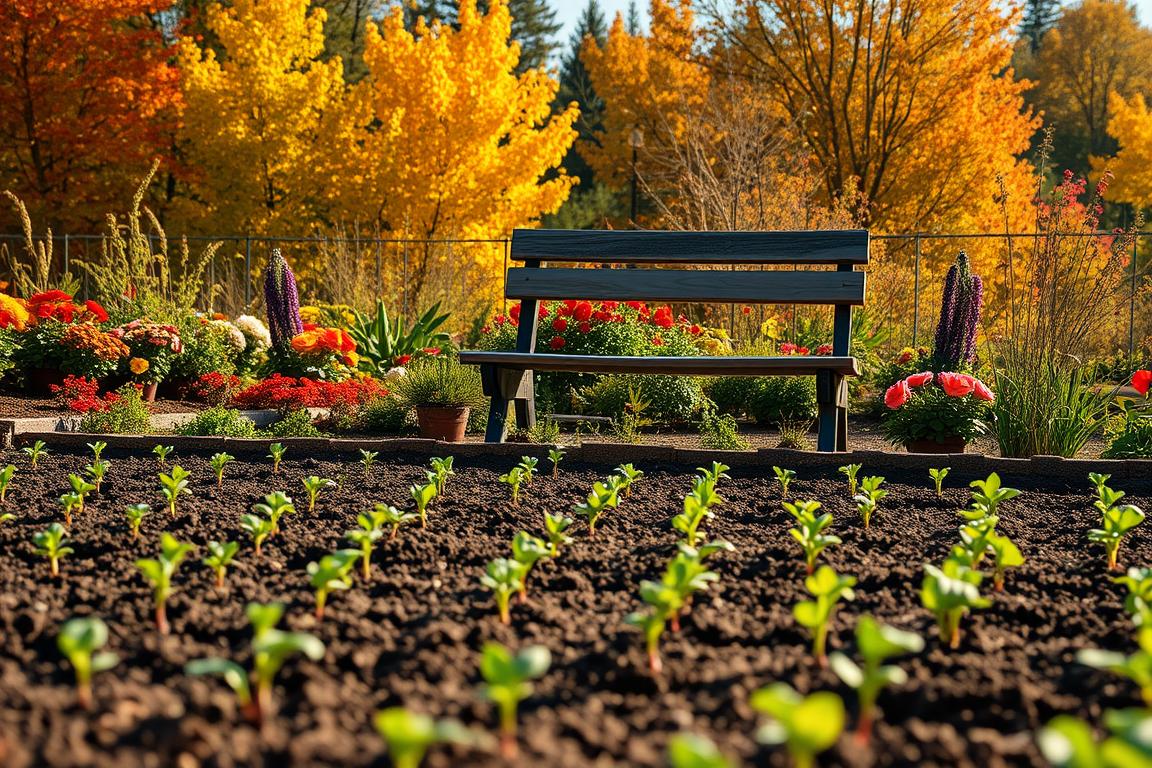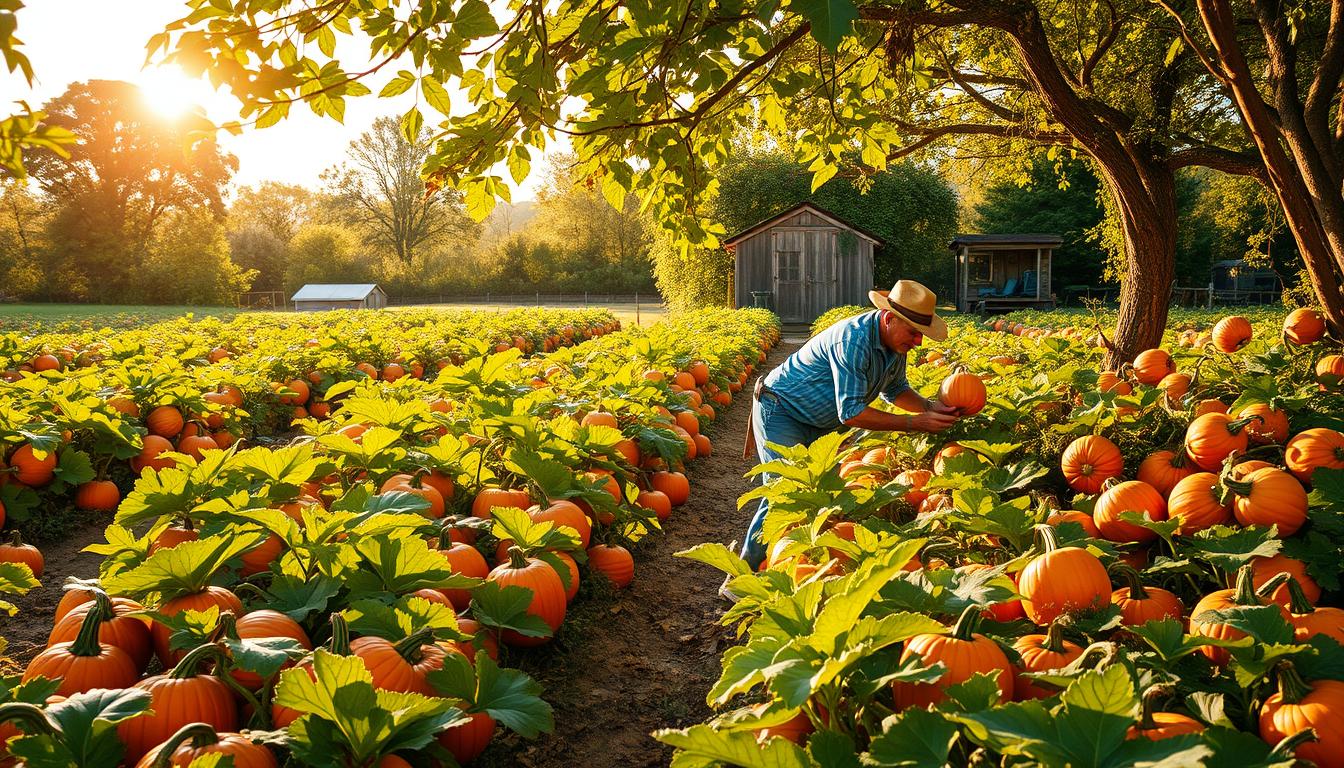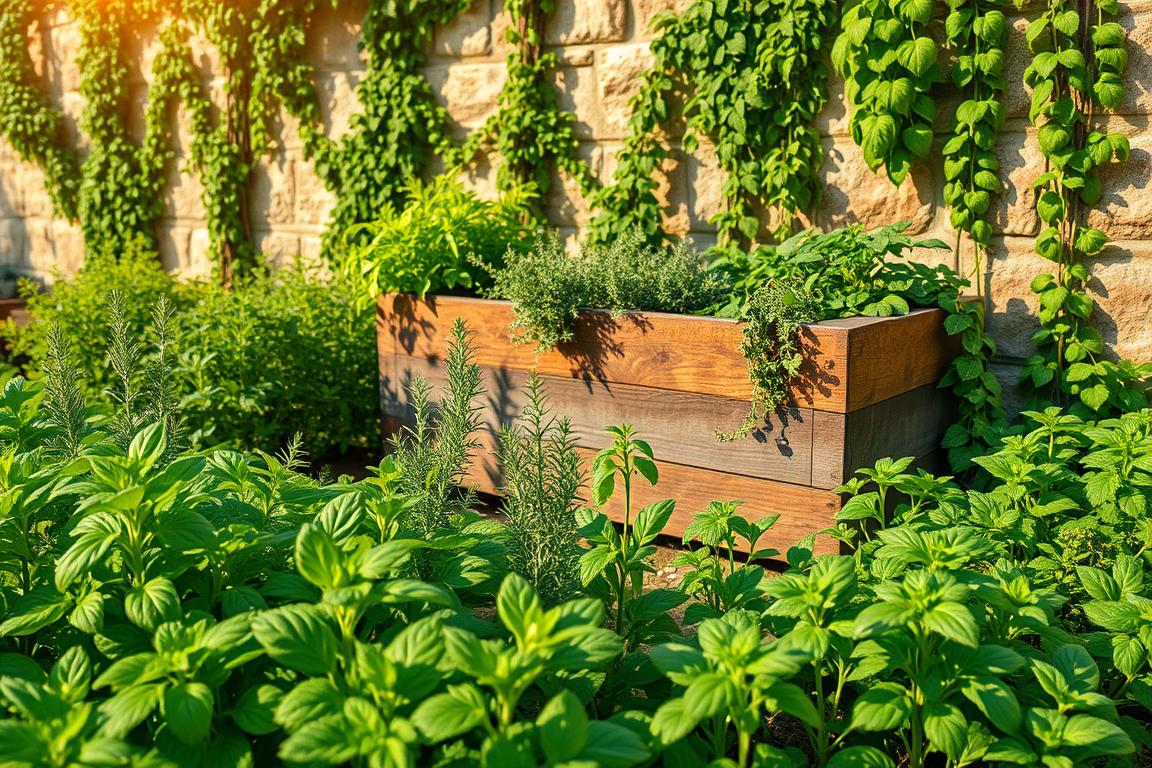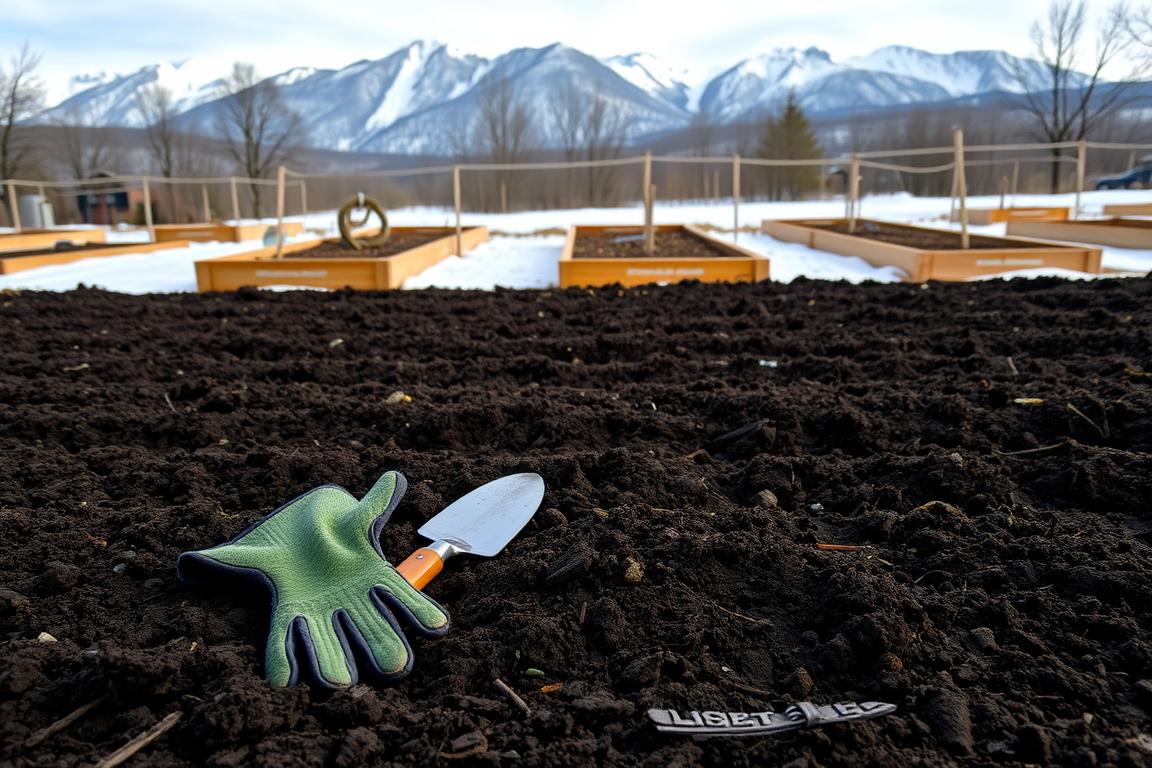Quality garden gloves are essential tools for any gardening enthusiast, providing crucial protection against thorns, soil-borne pathogens, and harsh chemicals while maintaining the dexterity needed for delicate tasks. In 2025, garden glove technology has evolved significantly, offering specialized materials, enhanced durability, and ergonomic designs that make gardening safer and more comfortable than ever before. Our comprehensive guide examines the top 7 garden gloves of 2025, comparing critical features like puncture resistance, waterproofing, and flexibility to help you find the perfect hand protection for your specific gardening needs.
Top 7 Garden Gloves 2025 Comparison
| Model | Puncture Resistance | Waterproofing | Material | Sizing | Special Features | Rating |
| Garrett Wade Puncture-Resistant Garden Gloves | Excellent | Moderate | Synthetic leather with aramid fiber | S-XXL | Reinforced fingertips, Extended wrist protection | 4.8/5 |
| Wells Lamont Hydra Leather Garden Gloves | Very Good | Excellent | Water-resistant leather | S-XL | HydraHyde technology, Adjustable wrist strap | 4.7/5 |
| Magid Handmaster Extra Long Garden Gloves | Good | Limited | Synthetic leather with nylon | S-L | 18-inch gauntlet, Padded palm | 4.5/5 |
| Foxgloves Garden Gloves | Moderate | Poor | Supplex nylon with spandex | XS-XL | Breathable mesh, Touchscreen compatible | 4.3/5 |
| Cool Job Garden Gloves | Good | Good | Nitrile-coated nylon | S-XL | Cooling technology, Non-slip grip | 4.4/5 |
| Pine Tree Garden Gloves | Very Good | Moderate | Bamboo fiber with latex coating | S-XL | Eco-friendly materials, Breathable back | 4.6/5 |
| Woheer Leather Thorn Proof Garden Gloves | Excellent | Good | Full-grain cowhide leather | M-XXL | Reinforced palm, Extended gauntlet cuff | 4.7/5 |
Our Top Pick: Garrett Wade Puncture-Resistant Garden Gloves
After extensive testing of the top garden gloves available in 2025, we’ve selected the Garrett Wade Puncture-Resistant Garden Gloves as our Editor’s Choice. These exceptional gloves offer the perfect balance of protection, dexterity, and comfort for serious gardeners. Their innovative design incorporates aramid fiber reinforcement in high-wear areas, providing superior puncture resistance against thorns and sharp branches without sacrificing flexibility. The extended wrist protection prevents debris from entering while the synthetic leather construction offers excellent durability and grip even in damp conditions.
Pros
- Superior puncture resistance with aramid fiber reinforcement
- Excellent dexterity for precision tasks
- Extended cuff prevents debris entry
Cons
- Premium price point
- Only moderate waterproofing
| S, M, L, XL, XXL | Tan, Green |
| 6.2 oz per pair | Fingertips, Palm, Knuckles |
| 4.5 inches | Synthetic leather with aramid fiber |
| Hand wash only | 1 year |
Get the Garrett Wade Puncture-Resistant Garden Gloves Today
Experience superior hand protection with our top-rated garden gloves of 2025.
Wells Lamont Hydra Leather Garden Gloves: Best Waterproof Option
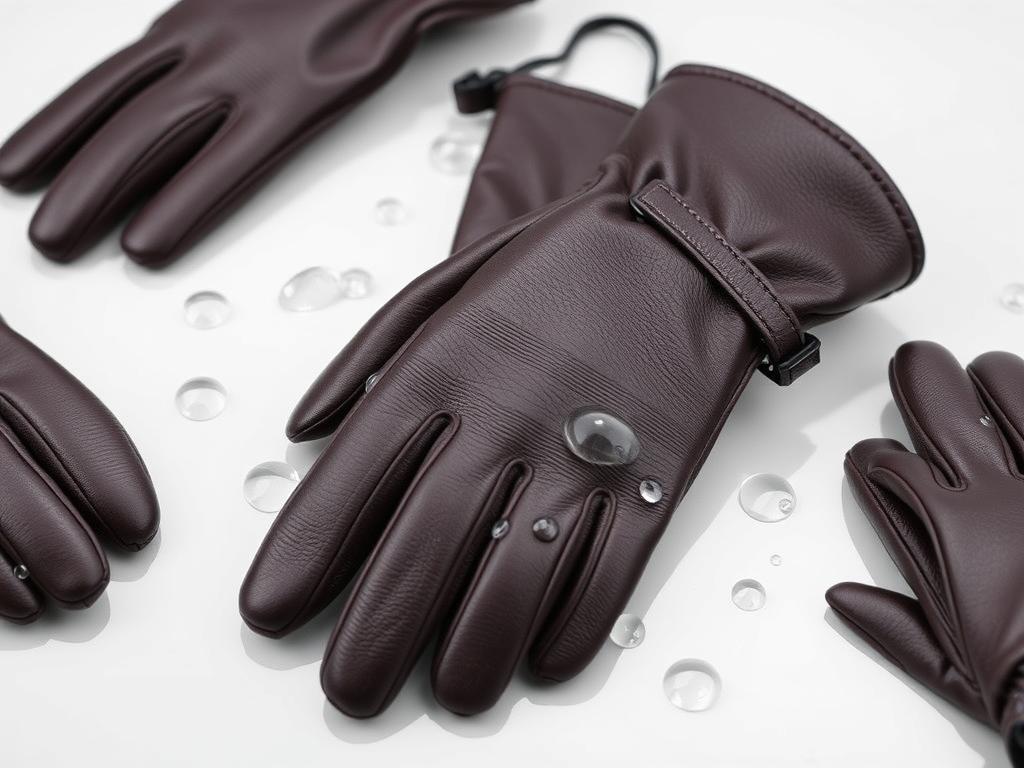
The Wells Lamont Hydra Leather Garden Gloves stand out in our 2025 lineup as the premier waterproof option for gardeners who work in wet conditions. These exceptional gloves utilize proprietary HydraHyde technology that creates a water-resistant barrier while maintaining the natural feel and flexibility of genuine leather. Perfect for early morning gardening with dew-covered plants or working with irrigation systems, these gloves keep hands dry without sacrificing the tactile sensitivity needed for detailed garden work.
Pros
- Exceptional water resistance with HydraHyde technology
- Genuine leather construction offers natural durability
- Adjustable wrist strap ensures secure fit
Cons
- Heavier than synthetic options
- Requires occasional leather conditioning
Key Specifications
| S, M, L, XL | Brown, Tan |
| 7.8 oz per pair | Palm, Thumb saddle |
| 3.5 inches | HydraHyde treated leather |
| Spot clean only | 90 days |
Get the Wells Lamont Hydra Leather Garden Gloves
Keep your hands dry and protected with these premium waterproof leather garden gloves.
Magid Handmaster Extra Long Garden Gloves: Best for Thorny Plants
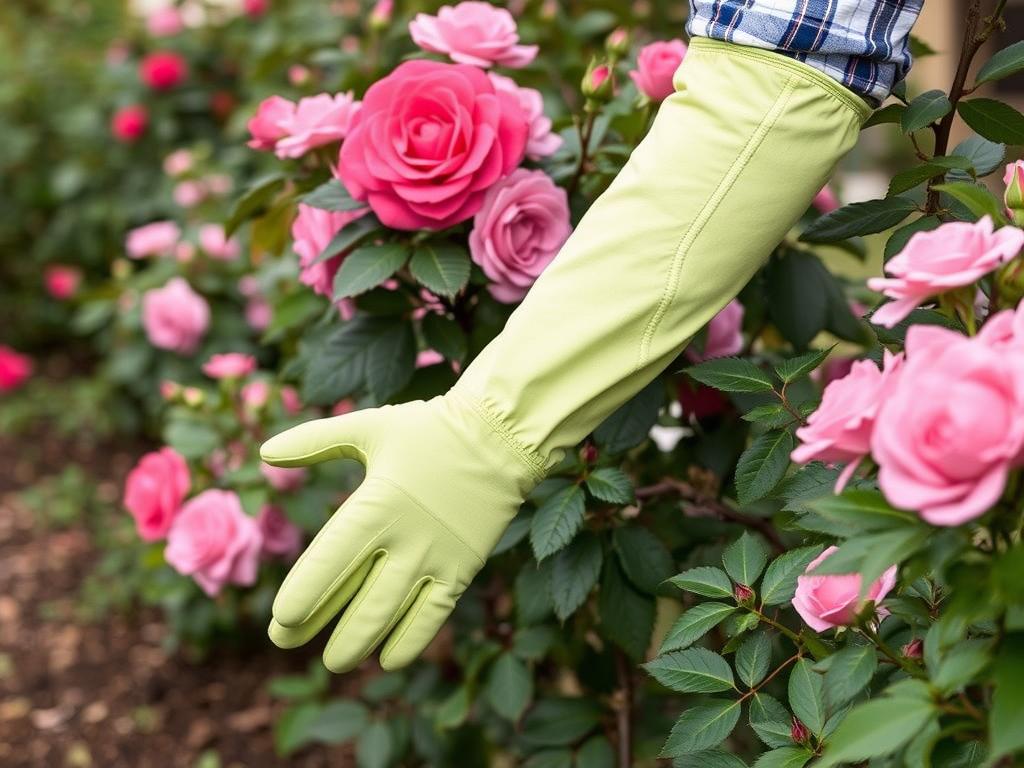
The Magid Handmaster Extra Long Garden Gloves are specifically designed for gardeners who battle thorny plants like roses, blackberries, and raspberries. The standout feature of these specialized gloves is their impressive 18-inch gauntlet that provides comprehensive protection from wrist to elbow, preventing painful scratches and punctures during pruning and maintenance tasks. Despite their protective length, these gloves maintain surprising dexterity in the fingertips, allowing for precision work while keeping your arms fully shielded from thorns and brambles.
Pros
- 18-inch gauntlet provides exceptional arm protection
- Padded palm enhances comfort during extended use
- Synthetic leather construction balances protection and flexibility
Cons
- Limited waterproofing capabilities
- Can be warm in hot weather
Key Specifications
| S, M, L | Green, Beige |
| 9.5 oz per pair | Palm, Fingertips, Forearm |
| 18 inches | Synthetic leather with nylon |
| Hand wash, air dry | 30 days |
Get the Magid Handmaster Extra Long Garden Gloves
Protect your hands and arms from thorns with these specialized extra-long garden gloves.
Foxgloves Garden Gloves: Best for Dexterity and Sensitivity

Foxgloves Garden Gloves excel in situations requiring maximum dexterity and tactile sensitivity, making them ideal for delicate tasks like transplanting seedlings, detailed weeding, and fine pruning work. These innovative gloves utilize a unique blend of Supplex nylon and spandex that creates a second-skin feel while still providing adequate protection for light gardening duties. The breathable mesh construction keeps hands cool and comfortable during extended wear, while the touchscreen compatibility allows for checking garden apps or answering calls without removing your gloves.
Pros
- Exceptional dexterity for detailed gardening tasks
- Breathable mesh keeps hands cool in hot weather
- Touchscreen compatible fingertips
Cons
- Limited protection against thorns and sharp objects
- Poor water resistance
Key Specifications
| XS, S, M, L, XL | Blue, Green, Purple, Black |
| 2.4 oz per pair | Fingertips only |
| 2.5 inches | Supplex nylon with spandex |
| Machine washable | 60 days |
Get the Foxgloves Garden Gloves
Experience unmatched dexterity and comfort for your detailed gardening tasks.
Cool Job Garden Gloves: Best for Hot Weather
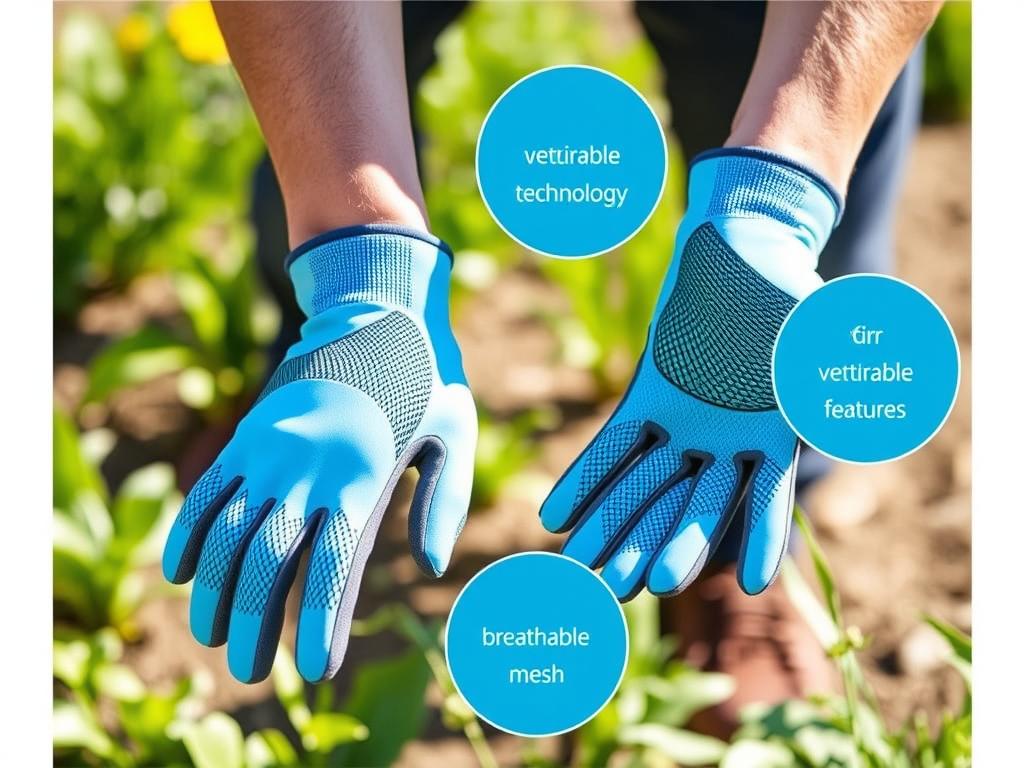
Cool Job Garden Gloves address one of the most common complaints among gardeners: overheated, sweaty hands during summer work. These innovative gloves utilize advanced cooling technology in their design, with moisture-wicking fabric and strategic ventilation zones that maintain comfortable hand temperature even during the hottest gardening sessions. The nitrile-coated palm and fingers provide excellent grip on tools and plants while offering good water resistance for working with irrigation or morning dew-covered vegetation.
Pros
- Superior cooling technology prevents overheating
- Excellent grip with nitrile-coated palm and fingers
- Good balance of protection and dexterity
Cons
- Less durable than leather options
- Limited protection against larger thorns
Key Specifications
| S, M, L, XL | Blue, Green, Pink |
| 3.6 oz per pair | Palm, Fingertips |
| 3 inches | Nitrile-coated nylon with cooling mesh |
| Machine washable, gentle cycle | 90 days |
Get the Cool Job Garden Gloves
Keep your hands cool and comfortable during hot weather gardening tasks.
Pine Tree Garden Gloves: Best Eco-Friendly Option
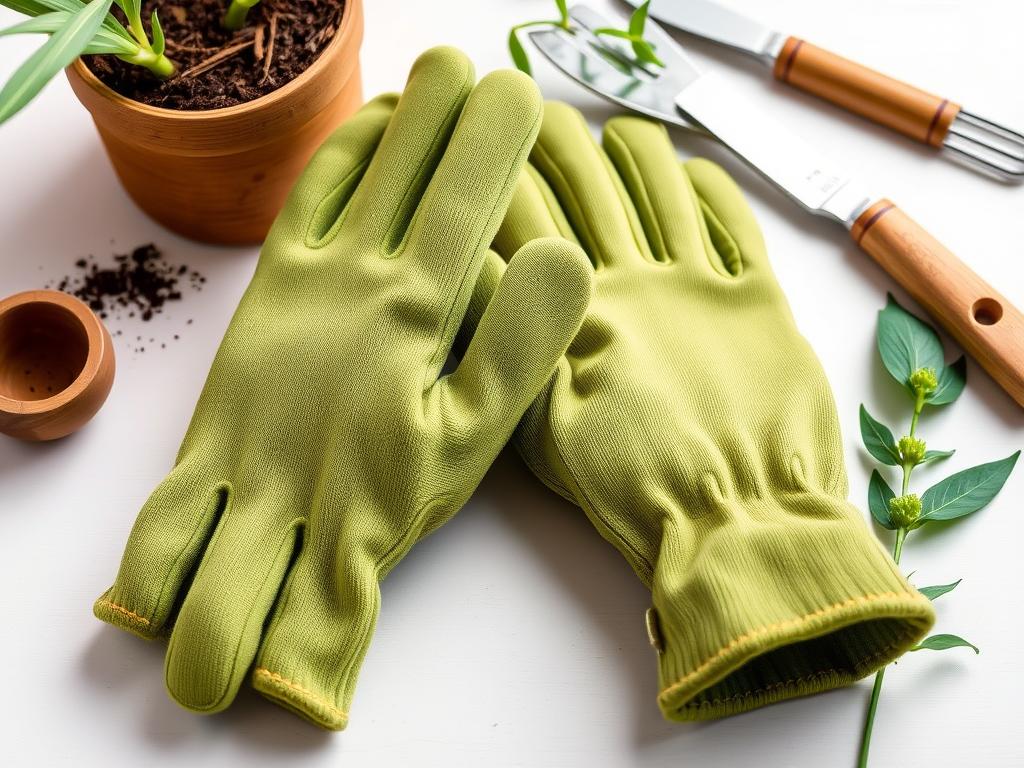
Pine Tree Garden Gloves represent the cutting edge of sustainable gardening equipment, utilizing eco-friendly bamboo fiber as their primary material. These environmentally conscious gloves offer the perfect combination of earth-friendly materials and practical functionality, with a natural latex coating on the palm and fingers that provides excellent grip and moderate puncture resistance. The bamboo fiber construction offers natural antibacterial properties that reduce odor development, while the breathable back keeps hands comfortable during extended gardening sessions.
Pros
- Sustainable bamboo fiber construction
- Natural antibacterial properties reduce odor
- Good balance of protection and breathability
Cons
- Latex coating may cause allergic reactions for some users
- Less durable than synthetic or leather options
Key Specifications
| S, M, L, XL | Natural Green |
| 4.2 oz per pair | Latex-coated palm and fingers |
| 3 inches | Bamboo fiber with latex coating |
| Hand wash, air dry | 1 year |
Get the Pine Tree Garden Gloves
Choose eco-friendly hand protection with these sustainable bamboo fiber garden gloves.
Woheer Leather Thorn Proof Garden Gloves: Best Heavy-Duty Option
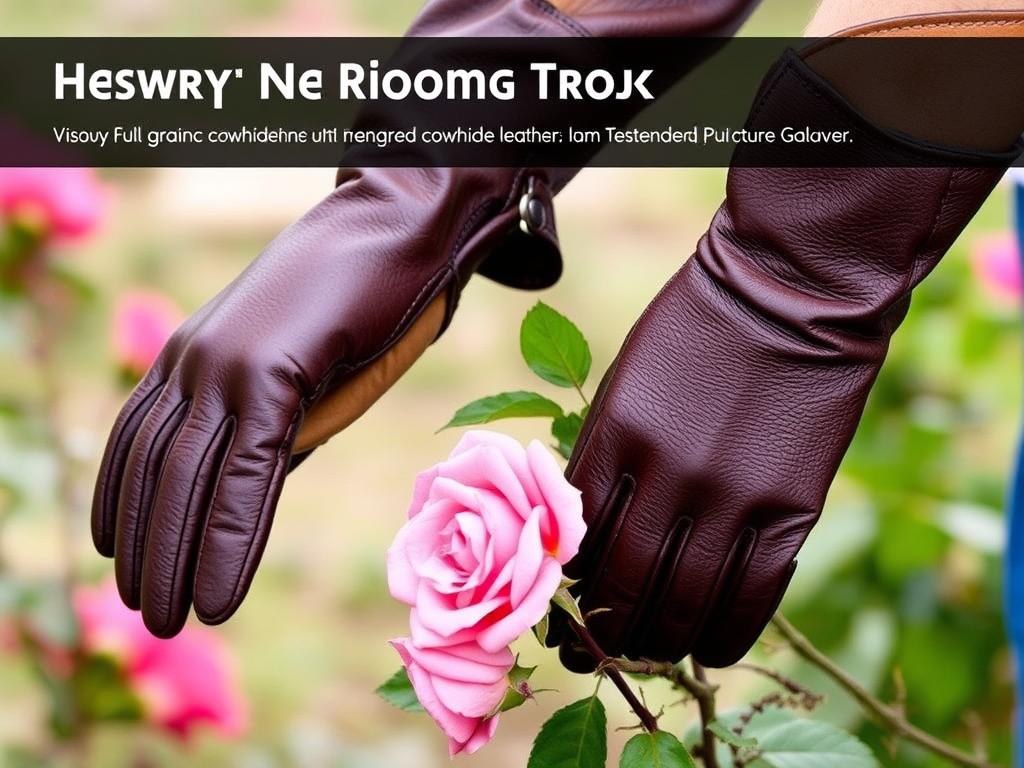
Woheer Leather Thorn Proof Garden Gloves represent the ultimate in heavy-duty hand protection for the most demanding gardening tasks. Constructed from premium full-grain cowhide leather, these rugged gloves offer exceptional puncture resistance against the sharpest thorns and branches. The reinforced palm provides additional protection in high-wear areas, while the extended gauntlet cuff shields wrists and forearms from scratches. Despite their heavy-duty construction, these gloves maintain reasonable dexterity for most gardening tasks, making them ideal for clearing brush, pruning thorny shrubs, or handling rough materials.
Pros
- Superior puncture resistance against thorns and sharp objects
- Exceptional durability for long-term use
- Extended gauntlet protects wrists and forearms
Cons
- Stiffer than synthetic options, especially when new
- Requires break-in period for optimal comfort
Key Specifications
| M, L, XL, XXL | Brown |
| 10.5 oz per pair | Double-layered palm, Knuckle protection |
| 5 inches | Full-grain cowhide leather |
| Spot clean only | 1 year |
Get the Woheer Leather Thorn Proof Garden Gloves
Experience maximum protection with these heavy-duty leather garden gloves.
Garden Gloves Buying Guide for 2025
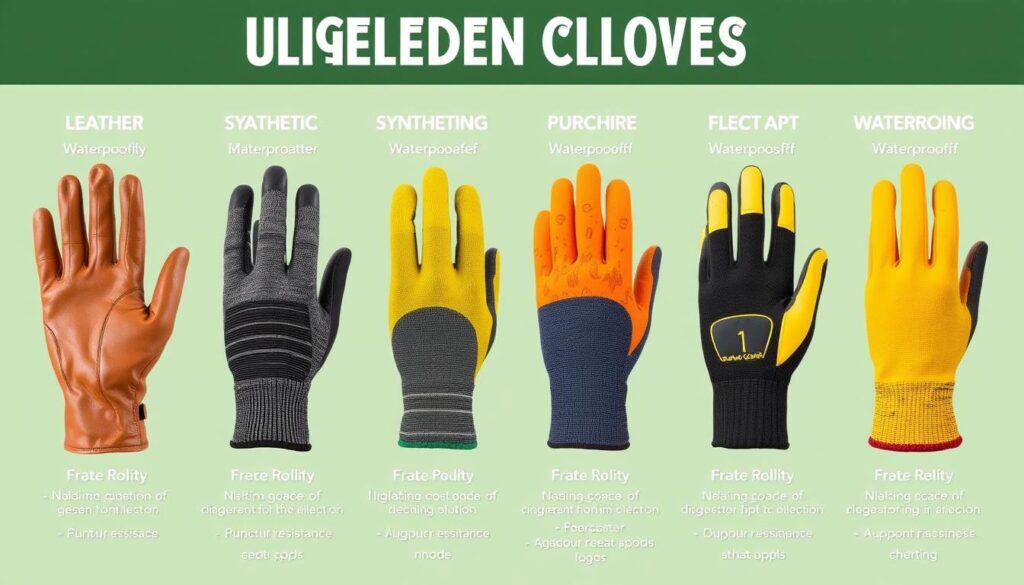
Selecting the ideal garden gloves in 2025 requires understanding several key factors that impact protection, comfort, and functionality. This comprehensive buying guide will help you navigate the important considerations to find the perfect hand protection for your specific gardening needs.
Understanding Garden Glove Materials
The material of your garden gloves significantly impacts their performance characteristics, including protection level, dexterity, comfort, and durability. Modern garden gloves utilize a variety of materials, each with distinct advantages for different gardening tasks.
Leather gloves represent the traditional choice for gardeners, offering excellent puncture resistance and durability. Full-grain leather, like that used in the Woheer Thorn Proof gloves, provides superior protection against thorns and sharp objects but typically offers less dexterity than synthetic options. Treated leather, such as the HydraHyde technology in Wells Lamont gloves, can add water resistance while maintaining leather’s protective qualities.
Synthetic materials have evolved significantly in recent years, with options ranging from aramid fibers (similar to Kevlar) for puncture resistance to specialized cooling fabrics. Synthetic gloves typically offer better dexterity and are often lighter and more breathable than leather alternatives. The Garrett Wade Puncture-Resistant gloves demonstrate how modern synthetic materials can provide protection comparable to leather while maintaining flexibility.
Coated gloves feature a fabric base (often nylon or cotton) with a coating on the palm and fingers made from materials like nitrile, latex, or polyurethane. These coatings enhance grip and provide water resistance while allowing the back of the hand to remain breathable. The Pine Tree Garden Gloves exemplify this approach with their bamboo fiber construction and latex coating.
Protection Level and Intended Use
Different gardening tasks require varying levels of hand protection. When evaluating garden gloves, consider your primary gardening activities and the protection they demand.
For light gardening tasks like planting seedlings, weeding soft soil, or harvesting vegetables, minimal protection gloves like the Foxgloves Garden Gloves offer sufficient protection while maximizing dexterity. These lightweight gloves protect against dirt and minor abrasions while allowing you to feel what you’re working with.
Medium-duty gardening, including general maintenance, light pruning, and working with slightly abrasive materials, benefits from gloves like the Cool Job Garden Gloves or Pine Tree Garden Gloves. These provide a good balance of protection and dexterity with reinforced palms and moderate puncture resistance.
Heavy-duty gardening tasks such as pruning thorny bushes, clearing brush, or handling rough materials require maximum protection gloves. The Woheer Leather Thorn Proof gloves and Magid Handmaster Extra Long gloves excel in these applications, with substantial puncture resistance and extended coverage for wrists and forearms.
Specialized gardening activities may require task-specific gloves. For example, working with chemicals or fertilizers benefits from waterproof options like the Wells Lamont Hydra Leather gloves, while hot weather gardening is more comfortable with cooling technology like that found in the Cool Job gloves.
Fit and Sizing Considerations
Proper fit is crucial for garden glove performance and comfort. Gloves that are too tight restrict movement and cause fatigue, while oversized gloves reduce dexterity and can create safety hazards when using tools.
To determine your correct glove size, measure the circumference of your dominant hand at its widest point (typically around the knuckles, excluding the thumb). Most manufacturers provide sizing charts that correlate these measurements to their specific sizing system. When between sizes, consider the material—leather gloves may stretch slightly with use, while synthetic materials typically maintain their original dimensions.
Women-specific gloves, available from several manufacturers in our 2025 lineup, feature proportions designed for typically smaller hands with different length-to-width ratios than men’s gloves. These gender-specific designs often provide a more precise fit that enhances both comfort and functionality.
Extended-wear comfort depends on factors beyond basic sizing. Look for features like pre-curved fingers that reduce hand fatigue, seamless fingertips that prevent irritation, and wrist closures that keep debris out while allowing ventilation. The Foxgloves Garden Gloves excel in extended-wear comfort with their second-skin design and breathable construction.
Durability and Construction Quality
The longevity of garden gloves depends largely on their construction quality and the materials used. When evaluating durability, examine these key factors:
- Seam Construction: Double-stitched seams with reinforcement at stress points indicate quality construction that will withstand repeated use. The Garrett Wade Puncture-Resistant gloves feature reinforced seams in high-wear areas for extended durability.
- Palm Reinforcement: Additional material layers or specialized coatings on the palm enhance durability where gloves experience the most abrasion. The Woheer Leather Thorn Proof gloves include double-layered palm reinforcement for maximum longevity.
- Finger Construction: Reinforced fingertips prevent the most common failure point in garden gloves. Look for wrapped fingertips or additional material layers, as seen in several of our top 2025 picks.
- Wrist Closure: Quality elastic, Velcro, or adjustable closures maintain a secure fit while allowing easy on/off. The Wells Lamont Hydra Leather gloves feature an adjustable wrist strap that maintains its elasticity over time.
Material quality varies significantly between price points. Premium full-grain leather, as used in the Woheer gloves, typically outlasts split leather or synthetic alternatives but commands a higher price. Similarly, higher-grade synthetic materials with specialized coatings generally offer better durability than basic cotton or polyester gloves.
Weather Adaptability and Seasonality
Garden gloves perform differently across various weather conditions and seasons. The ideal gloves for summer gardening may prove inadequate for early spring or late fall work.
For hot weather gardening, breathability and moisture management become critical factors. The Cool Job Garden Gloves specifically address this challenge with cooling technology and strategic ventilation that prevents overheating. Lightweight, breathable materials like those used in the Foxgloves Garden Gloves also excel in warm conditions.
Cold weather gardening requires gloves that balance insulation with maintained dexterity. While none of our top 2025 picks are specifically designed as winter garden gloves, the Wells Lamont Hydra Leather gloves offer moderate insulation while maintaining water resistance, making them suitable for cool, damp conditions.
Wet conditions demand waterproof or water-resistant materials to keep hands dry and prevent the discomfort of soggy gloves. The HydraHyde technology in the Wells Lamont gloves provides excellent water resistance, while the nitrile coating on the Cool Job gloves offers moderate protection against moisture.
Consider your local climate and typical gardening season when selecting gloves. Gardeners in regions with distinct seasons may benefit from owning multiple pairs optimized for different weather conditions, while those in more consistent climates might prioritize other features.
Special Features and Innovations
The garden glove market in 2025 offers numerous specialized features and technological innovations that enhance functionality for specific needs:
- Extended Cuffs: Gauntlet-style gloves like the Magid Handmaster Extra Long provide protection beyond the wrist, shielding forearms from scratches when working with thorny plants or dense vegetation.
- Touchscreen Compatibility: Conductive material in fingertips, as featured in the Foxgloves Garden Gloves, allows use of smartphones and tablets without removing gloves—convenient for referencing garden apps or taking photos.
- Cooling Technology: Advanced fabric treatments and ventilation systems, like those in the Cool Job Garden Gloves, actively manage hand temperature during hot weather gardening.
- Eco-Friendly Materials: Sustainable options like the bamboo fiber used in Pine Tree Garden Gloves appeal to environmentally conscious gardeners while offering natural antibacterial properties.
- Ergonomic Design: Pre-curved fingers and anatomical shaping reduce hand fatigue during extended use. Several of our top 2025 picks incorporate ergonomic elements that improve comfort and reduce strain.
While innovative features can enhance functionality, they sometimes come with trade-offs in other areas. For example, touchscreen compatibility may slightly reduce puncture resistance, while extended cuffs can limit wrist flexibility. Prioritize features that address your specific gardening challenges rather than selecting gloves with the most innovations.
Maintenance and Cleaning
Proper maintenance significantly extends garden glove lifespan and preserves their protective qualities. Different materials require specific cleaning approaches:
- Leather Gloves: Spot clean with a damp cloth and mild soap, avoiding saturation. Allow to air dry away from direct heat, then apply leather conditioner occasionally to maintain suppleness. The Woheer Leather Thorn Proof and Wells Lamont Hydra Leather gloves require this maintenance approach.
- Synthetic Gloves: Many synthetic gloves are machine washable on gentle cycles with mild detergent. The Foxgloves Garden Gloves and Cool Job Garden Gloves can be machine washed for convenient cleaning.
- Coated Gloves: Hand wash with mild soap and cool water, avoiding harsh detergents that can degrade the coating. The Pine Tree Garden Gloves with their latex coating should be hand washed to preserve their grip properties.
Regular inspection helps identify damage before it compromises protection. Check for punctures, thinning materials, or seam separation after working with abrasive materials or thorny plants. Catching minor damage early often allows for repairs that extend glove life.
Proper storage between uses prevents unnecessary degradation. Store gloves in a cool, dry location away from direct sunlight, which can degrade both natural and synthetic materials. Some gardeners use glove clips or dedicated storage solutions to keep pairs together and properly shaped.
Budget and Value Considerations
Garden gloves in 2025 span a wide price range, from budget options under $10 to premium specialized gloves exceeding $50. When assessing value, consider the total cost of ownership:
- Initial Purchase Price: Entry-level options like basic cotton gloves offer minimal protection at low cost, while specialized gloves like the Garrett Wade Puncture-Resistant command premium prices for advanced materials and construction.
- Expected Lifespan: More durable gloves may cost more initially but require less frequent replacement. The Woheer Leather Thorn Proof gloves represent this value proposition, with higher upfront cost offset by exceptional durability.
- Specialized Functionality: Task-specific gloves like the Magid Handmaster Extra Long may seem expensive compared to general-purpose options but provide value through their specialized protection for specific gardening challenges.
- Warranty Coverage: Longer warranties indicate manufacturer confidence in product durability. The one-year warranties on the Garrett Wade, Pine Tree, and Woheer gloves suggest superior construction compared to competitors with shorter coverage.
For occasional gardeners, mid-range options like the Cool Job or Pine Tree Garden Gloves offer a good balance of protection and value. Dedicated gardeners who spend significant time working with plants may find greater value in premium options like the Garrett Wade Puncture-Resistant gloves, which offer enhanced protection and comfort for extended use.
Consider maintaining multiple pairs for different tasks rather than seeking a single “perfect” glove. This approach allows you to select the optimal protection level for each gardening activity while extending the lifespan of your entire glove collection.
Specialized Garden Gloves for Different Tasks
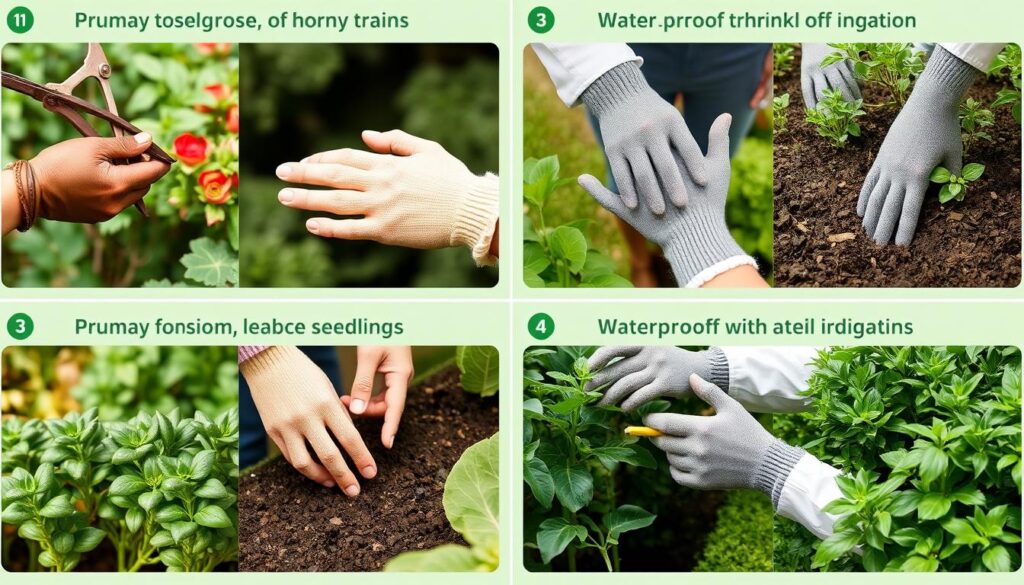
Different gardening activities present unique challenges for hand protection. Understanding which gloves excel for specific tasks helps you select the right protection for every gardening project. This section explores how our top garden gloves for 2025 perform across various specialized gardening activities.
Rose Pruning and Thorny Plant Management
Working with roses, blackberries, raspberries, and other thorny plants requires exceptional puncture resistance and extended coverage to protect both hands and forearms. For these challenging tasks, two gloves in our 2025 lineup stand out:
The Woheer Leather Thorn Proof Garden Gloves offer superior puncture resistance with their full-grain cowhide construction and reinforced palm. The thick leather effectively blocks even sharp thorns, while the extended 5-inch gauntlet provides wrist protection. These gloves excel when working with established rose bushes or clearing thorny brush.
For more extensive arm protection, the Magid Handmaster Extra Long Garden Gloves provide unmatched coverage with their 18-inch gauntlet. While offering slightly less puncture resistance than the Woheer leather gloves, they compensate with protection that extends nearly to the elbow, making them ideal for reaching deep into thorny bushes or working with climbing roses.
When pruning thorny plants, pair either of these protective gloves with proper pruning techniques: use sharp, clean tools; approach stems at the correct angle; and avoid overreaching into dense growth. Even the best gloves have limitations, so thoughtful work practices enhance your protection.
Delicate Seedling Work and Transplanting
Handling delicate seedlings, performing precision weeding, or transplanting young plants requires maximum dexterity and tactile sensitivity. For these fine motor tasks, gloves that offer a “barely-there” feel while still providing basic soil protection are ideal.
The Foxgloves Garden Gloves excel in this category with their ultra-thin, form-fitting design that maintains exceptional dexterity. Their touchscreen compatibility allows checking plant identification apps or garden planning tools without removing gloves, while their breathable construction prevents overheating during detail-oriented work that may require extended concentration.
The Pine Tree Garden Gloves also perform well for delicate work, with their natural bamboo fiber construction offering slightly more protection than the Foxgloves while maintaining good sensitivity. The latex coating provides enhanced grip for handling small tools or containers without sacrificing too much dexterity.
When working with seedlings, consider keeping multiple pairs of these dexterity-focused gloves available, as soil moisture can quickly penetrate the lightweight materials. Alternating between pairs allows one set to dry while you continue working with clean, dry gloves.
Wet Condition Gardening and Irrigation Work
Gardening in rainy conditions, morning dew, or working with irrigation systems requires gloves that maintain their protective qualities and comfort when wet. Waterproof or highly water-resistant gloves prevent the discomfort and potential blistering associated with soggy hand protection.
The Wells Lamont Hydra Leather Garden Gloves stand out for wet condition work, with their HydraHyde technology creating an effective moisture barrier while maintaining leather’s durability and protection. Unlike fully waterproof rubber gloves, these allow some breathability while keeping the majority of moisture away from hands.
The Cool Job Garden Gloves offer a different approach to wet condition work, with nitrile coating that repels water while maintaining excellent grip on slippery tools or plants. Their quick-drying construction makes them suitable for intermittently wet conditions, though they provide less waterproofing than the Wells Lamont option.
For extended work in very wet conditions, consider waterproof glove liners worn under your regular garden gloves, or dedicated waterproof options beyond our top 2025 picks. This specialized approach may be necessary for extensive irrigation work or gardening in consistently rainy climates.
Heavy Soil Work and Digging
Preparing garden beds, extensive digging, or working with rocky or clay soils creates significant abrasion that quickly wears through lesser gloves. These high-wear activities benefit from gloves with reinforced palms and substantial construction.
The Garrett Wade Puncture-Resistant Garden Gloves excel for heavy soil work with their aramid fiber reinforcement in high-wear areas. This specialized material resists abrasion from rough soil particles while maintaining enough flexibility for comfortable tool handling. The extended cuff prevents soil from entering the gloves during intensive digging.
The Woheer Leather Thorn Proof Garden Gloves also perform exceptionally well for heavy soil work, with their thick leather construction and double-layered palm reinforcement. These gloves withstand the friction of shovel handles and abrasive soil while providing excellent blister protection during repetitive digging motions.
When engaging in extensive soil preparation, consider the ergonomics of your tools alongside your glove choice. Well-designed tools with comfortable grips reduce the strain on gloves and hands, extending both glove lifespan and your gardening comfort.
Hot Weather Gardening
Gardening in high temperatures presents unique challenges, as hands quickly overheat and sweat inside conventional gloves. This discomfort can lead gardeners to remove gloves entirely, sacrificing protection. Specialized hot weather gloves address this problem through innovative materials and designs.
The Cool Job Garden Gloves are specifically engineered for hot weather performance, with moisture-wicking fabric and ventilation zones that maintain comfortable hand temperature. Their lightweight construction minimizes heat retention while still providing adequate protection for most summer gardening tasks.
The Foxgloves Garden Gloves also excel in hot conditions, with their ultra-lightweight, breathable construction allowing significant airflow. While offering less protection than the Cool Job gloves, they provide a barely-there feel that’s comfortable even in high temperatures.
For extended hot weather gardening, consider rotating between multiple pairs of gloves, allowing each to dry completely between uses. This practice improves comfort and extends glove lifespan by preventing the breakdown of materials from constant moisture exposure.
Chemical and Fertilizer Handling
Working with garden chemicals, fertilizers, or potentially irritating plant compounds requires gloves that create an effective barrier against these substances. While specialized chemical-resistant gloves are recommended for concentrated products, several of our top 2025 picks offer good protection for general garden chemical applications.
The Wells Lamont Hydra Leather Garden Gloves provide good chemical resistance with their water-resistant barrier, which also blocks many common garden chemicals and fertilizers. Their substantial construction prevents quick penetration of potentially irritating substances.
The Cool Job Garden Gloves offer chemical resistance through their nitrile coating, which creates an effective barrier against many garden treatments. The complete coverage of the palm and fingers protects the areas most likely to contact chemicals during application.
When working with any garden chemicals, remember that no general gardening glove provides complete protection against all substances. For concentrated products or known skin irritants, pair appropriate garden gloves with careful application techniques and thorough washing afterward.
Garden Glove Care and Maintenance
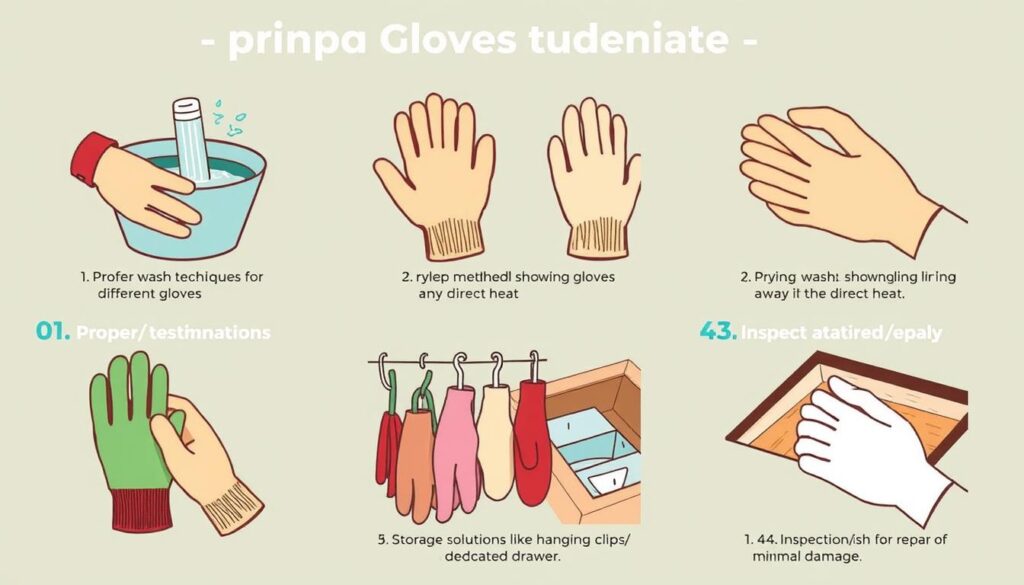
Proper care and maintenance significantly extend the lifespan of garden gloves while ensuring they continue to provide optimal protection and comfort. Different glove materials require specific maintenance approaches to preserve their protective qualities and fit. This comprehensive guide will help you maximize the value of your garden glove investment through proper cleaning, storage, and repair techniques.
Cleaning Different Glove Materials
Effective cleaning removes soil, plant residues, and potential pathogens without damaging glove materials or compromising protective features. Follow these material-specific cleaning guidelines for best results:
Leather Garden Gloves
Leather gloves like the Woheer Leather Thorn Proof and Wells Lamont Hydra Leather require gentle cleaning to maintain their protective qualities:
- Remove excess soil by brushing with a soft brush or cloth
- Spot clean dirty areas using a cloth slightly dampened with water and mild soap
- Avoid soaking or immersing leather gloves in water
- Gently pat with a clean, dry cloth to remove soap residue
- Allow to air dry completely away from direct heat or sunlight
- Once dry, apply a small amount of leather conditioner to maintain suppleness
For treated leather gloves with waterproofing features, like the Wells Lamont Hydra Leather, minimize the use of soaps that might degrade the water-resistant treatment. If these gloves become heavily soiled, clean as above and consider reapplying a leather waterproofing product designed for work gloves.
Synthetic and Fabric Garden Gloves
Synthetic gloves like the Garrett Wade Puncture-Resistant and Foxgloves typically tolerate more thorough cleaning:
- Check manufacturer’s instructions—many synthetic gloves are machine washable
- If machine washing, use a gentle cycle with cold water and mild detergent
- Place gloves in a mesh laundry bag to prevent damage to reinforced areas
- Avoid bleach, fabric softeners, or harsh detergents that can degrade synthetic materials
- Air dry completely—never use a dryer as heat can damage adhesives and elastic components
For synthetic gloves with special features like the aramid fiber reinforcement in Garrett Wade gloves, hand washing may better preserve these protective elements. Use the same gentle detergent and cold water, washing by hand with minimal agitation.
Coated Garden Gloves
Gloves with nitrile, latex, or other coatings like the Cool Job Garden Gloves and Pine Tree Garden Gloves require special attention to preserve their grip and water resistance:
- Hand wash with mild soap and cool water
- Avoid scrubbing the coated portions, which can cause flaking or cracking
- Rinse thoroughly to remove all soap residue
- Hang to dry with coated side out
- Avoid folding or creasing while wet, which can create permanent damage to the coating
For bamboo fiber gloves like the Pine Tree Garden Gloves, minimize agitation during washing to prevent fiber breakdown. Their natural antibacterial properties help reduce odor development, but regular cleaning still extends their useful life.
Drying and Storage Best Practices
Proper drying and storage between uses prevents mildew, maintains glove shape, and preserves protective features:
Effective Drying Techniques
- Always dry gloves completely before storage—even slightly damp gloves can develop mildew
- Air dry at room temperature away from direct heat sources like radiators, which can crack leather or damage synthetic materials
- Avoid direct sunlight, which can fade colors and degrade materials
- For faster drying, insert crumpled newspaper or a glove form to maintain shape and absorb moisture
- Rotate between multiple pairs of gloves to ensure each set dries completely between uses
For gloves used in wet conditions, like the Wells Lamont Hydra Leather, proper drying is especially critical. Turn these gloves inside out halfway through drying to ensure the interior dries completely, preventing the growth of mildew that can cause skin irritation.
Optimal Storage Solutions
- Store clean, dry gloves in a cool, dry location away from direct sunlight
- Use glove clips, pegs, or dedicated storage containers to keep pairs together
- Maintain glove shape during storage—consider inserting glove forms or even rolled washcloths
- For leather gloves, ensure adequate air circulation to prevent mildew
- Keep garden gloves separate from household gloves to prevent cross-contamination
Consider organizing multiple pairs by task type or level of protection. This system helps you quickly select the appropriate gloves for each gardening activity while preventing unnecessary wear on your premium pairs during light-duty tasks.
Extending Glove Lifespan
Beyond basic cleaning and storage, several practices can significantly extend garden glove longevity:
Regular Inspection and Maintenance
- Examine gloves regularly for signs of wear, particularly at seams and high-friction areas
- Address minor damage promptly before it expands—small holes or tears can often be repaired
- Remove embedded thorns or sharp objects immediately, as they continue to damage materials
- For leather gloves, apply conditioner every 5-10 uses to maintain suppleness and prevent cracking
- Check elastic components and closures for stretching or degradation
The reinforced areas in premium gloves like the Garrett Wade Puncture-Resistant typically show wear before catastrophic failure occurs. Watching for thinning in these regions allows you to adjust usage patterns or perform repairs before protection is compromised.
Repair Techniques for Common Issues
- Small holes in synthetic gloves can often be repaired with specialized fabric glue or patches
- Leather gloves with minor damage may be patched using leather repair kits
- Loose seams can be reinforced with appropriate heavy-duty thread and a leather needle
- Stretched elastic can sometimes be rejuvenated by soaking in cold water with a few drops of hydrogen peroxide
- For coated gloves with flaking palm coating, specialized tool handle dip products can sometimes restore grip
While not all damage is repairable, addressing minor issues can extend glove life significantly. Consider keeping a simple repair kit with appropriate adhesives and reinforcement materials for your specific glove types.
Task-Appropriate Glove Selection
Using the right gloves for each task not only improves protection but also extends the lifespan of your entire glove collection:
- Reserve heavy-duty gloves like the Woheer Leather Thorn Proof for appropriate tasks—using them for light weeding unnecessarily accelerates wear
- Keep specialized gloves like the Magid Handmaster Extra Long for their intended purpose (thorny plant management) rather than general gardening
- Use lightweight, high-dexterity gloves like the Foxgloves for delicate tasks, reducing strain on more protective pairs
- Consider dedicated “dirty work” gloves for soil preparation and construction tasks that cause accelerated wear
This strategic approach to glove selection creates a comprehensive hand protection system where each pair serves its optimal purpose, maximizing the value of your garden glove investment.
Seasonal Considerations
Different seasons present unique challenges for garden glove maintenance and storage:
End-of-Season Care
- Thoroughly clean all gloves before off-season storage
- Ensure gloves are completely dry before storing for extended periods
- Apply appropriate conditioners or protectants to leather gloves
- Store in breathable containers that prevent pest access while allowing air circulation
- Check periodically during off-season for signs of mildew or pest damage
For gardeners in regions with distinct growing seasons, this end-of-season maintenance ensures your gloves remain in optimal condition for the next gardening cycle.
Winter Storage and Cold Weather Considerations
Cold weather presents unique challenges for garden glove materials:
- Leather gloves can become stiff and less comfortable in cold conditions—store at room temperature and warm briefly before use
- Synthetic gloves may become less flexible in extreme cold—consider storing pairs indoors rather than in unheated sheds or garages
- Coated gloves can crack if flexed when extremely cold—allow them to warm to at least 50°F before use
- Winter moisture can promote mildew—ensure storage areas remain dry throughout the season
For year-round gardeners, maintaining gloves during winter months requires additional attention to temperature and humidity conditions. Consider keeping winter gardening gloves separate from fair-weather pairs to address these specialized needs.
Seasonal Garden Glove Selection Guide
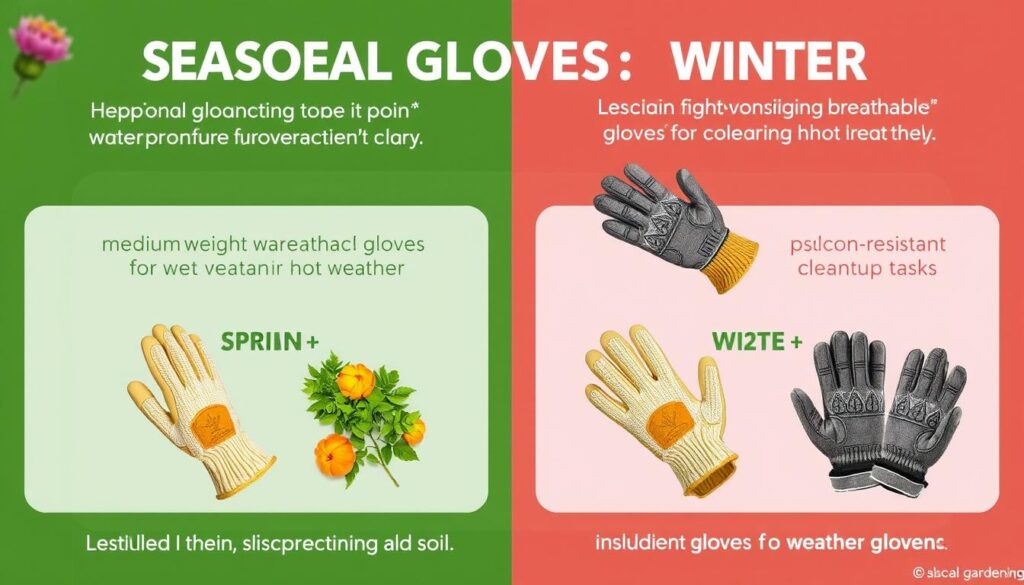
Different gardening seasons present unique challenges for hand protection, from the wet soil of early spring to the freezing temperatures of winter gardening. Selecting season-appropriate gloves enhances both comfort and protection while extending the lifespan of your garden glove collection. This seasonal guide helps you match our top garden gloves for 2025 to the specific requirements of year-round gardening.
Spring Gardening Gloves
Spring gardening involves working with damp soil, early planting, and garden bed preparation. The primary challenges for gloves during this season include moisture management and balancing protection with the dexterity needed for seed starting and transplanting.
The Wells Lamont Hydra Leather Garden Gloves excel as primary spring gardening gloves due to their excellent water resistance and moderate insulation against cool morning temperatures. Their HydraHyde technology prevents the discomfort of wet gloves while maintaining enough dexterity for typical spring planting tasks. The adjustable wrist strap keeps soil from entering during bed preparation and prevents drafts during cooler days.
For delicate spring tasks like transplanting seedlings or precision weeding around emerging perennials, the Foxgloves Garden Gloves provide the necessary dexterity while offering basic protection against soil and minor irritants. Their breathable construction adapts well to fluctuating spring temperatures, while their machine washability accommodates frequent cleaning during this busy gardening season.
Spring gardening tips for glove management include:
- Keep multiple pairs in rotation to ensure you always have dry gloves available
- Rinse gloves after working with spring fertilizers to prevent material degradation
- Select lighter colors that reflect spring sunlight and remain cooler as temperatures rise
- Consider waterproof gloves with breathable backs for optimal spring performance
Summer Gardening Gloves
Summer gardening presents challenges of heat management, increased insect activity, and the need for protection during intensive maintenance tasks. Ideal summer gloves balance ventilation with adequate protection against thorns, insects, and sun exposure.
The Cool Job Garden Gloves represent the optimal summer gardening solution with their specialized cooling technology and strategic ventilation. These innovative gloves actively manage hand temperature while providing good protection for most summer maintenance tasks. Their nitrile coating offers excellent grip even when handling sweaty tools, while their machine washability accommodates frequent cleaning to remove accumulated sunscreen, sweat, and plant residues.
For heavy-duty summer tasks like pruning established shrubs or clearing overgrown areas, the Garrett Wade Puncture-Resistant Garden Gloves provide necessary protection while maintaining reasonable breathability. Their synthetic construction balances protection and ventilation better than leather alternatives for hot weather work.
Summer gardening tips for glove management include:
- Rinse gloves with cool water between tasks to reduce heat buildup
- Select lighter colors that reflect sunlight and remain cooler
- Consider fingerless options for brief, light-duty tasks during extreme heat
- Maintain multiple pairs in rotation to allow complete drying between uses
- Store summer gloves out of direct sunlight to prevent material degradation
Fall Gardening Gloves
Fall gardening involves cleanup tasks, bulb planting, and preparation for winter. The primary challenges include protection from sharp plant material during cleanup, insulation against cooling temperatures, and adaptability to variable weather conditions.
The Woheer Leather Thorn Proof Garden Gloves excel for fall cleanup tasks with their superior puncture resistance and durability. These heavy-duty gloves protect hands from thorny brush, dead plant stalks, and other sharp materials encountered during intensive fall garden preparation. Their substantial construction also provides moderate insulation against cooling temperatures while maintaining necessary dexterity for bulb planting and other fall tasks.
For wet fall conditions, the Wells Lamont Hydra Leather Garden Gloves again prove valuable with their water resistance and moderate insulation. These versatile gloves handle morning frost and fall rain while providing good protection for most seasonal tasks. Their leather construction offers better thermal properties than synthetic alternatives as temperatures begin to drop.
Fall gardening tips for glove management include:
- Clean gloves thoroughly after handling fall leaves to prevent mold development
- Apply leather conditioner to leather gloves before heavy fall use to improve water resistance
- Consider layering thin liner gloves under main gloves during early morning work
- Ensure complete drying between uses as fall drying times extend with cooler temperatures
Winter Gardening Gloves
Winter gardening, though limited in many regions, includes tasks like pruning dormant plants, winter harvest in mild climates, and greenhouse work. The primary challenges involve balancing insulation with necessary dexterity and protecting hands from cold, wet conditions.
While none of our top garden gloves for 2025 are specifically designed as winter gardening gloves, several can adapt to mild winter conditions with appropriate modifications. The Wells Lamont Hydra Leather Garden Gloves provide good cold weather performance with their water resistance and leather construction that offers natural insulation. For moderate winter conditions, these gloves can be paired with thin thermal liners to enhance warmth while maintaining reasonable dexterity.
For brief winter gardening tasks in cold conditions, the Woheer Leather Thorn Proof Garden Gloves offer good protection with their substantial construction and extended gauntlet that prevents cold air entry. Their thick leather provides natural insulation, though at some cost to dexterity for precision tasks.
Winter gardening tips for glove management include:
- Warm gloves indoors before use to improve flexibility and comfort
- Consider dedicated winter gardening gloves with thermal insulation for extended tasks
- Use thin liner gloves beneath regular garden gloves for added warmth
- Ensure gloves dry completely between uses, as winter drying times extend significantly
- Apply appropriate leather conditioners to prevent cracking in cold, dry conditions
Transitional Season Considerations
The transitions between seasons often present the most variable conditions for gardeners. During these periods, versatility and adaptability become particularly valuable glove characteristics.
For the spring-to-summer transition, gloves that balance moisture management with increasing heat protection prove most valuable. The Pine Tree Garden Gloves offer good performance during this transition, with their breathable bamboo fiber construction adapting to warming temperatures while their latex coating maintains grip in both wet and dry conditions.
For the summer-to-fall transition, gloves that combine good protection with moderate insulation work best. The Garrett Wade Puncture-Resistant Garden Gloves provide excellent versatility during this period, with protection sufficient for fall cleanup tasks while maintaining enough breathability for warm days.
Transitional season tips for glove management include:
- Keep multiple glove types accessible as conditions can change rapidly
- Layer gloves appropriately—thin liner gloves can convert summer gloves to transitional options
- Check weather forecasts to anticipate appropriate glove selection
- Clean gloves more frequently during transitions as they encounter more variable conditions
By strategically selecting season-appropriate garden gloves and properly maintaining them throughout the year, you can ensure optimal hand protection and comfort for every gardening task across all seasons. This approach maximizes both the performance and longevity of your garden glove collection while enhancing your gardening experience year-round.
Frequently Asked Questions About Garden Gloves
How do I determine my correct garden glove size?
To determine your correct garden glove size, measure the circumference of your dominant hand at its widest point (typically around the knuckles, excluding the thumb) using a flexible measuring tape. Most manufacturers provide sizing charts that correlate these measurements to their specific sizing system (S, M, L, XL, etc.). When between sizes, consider the material—leather gloves may stretch slightly with use, while synthetic materials typically maintain their original dimensions. For the most accurate fit, consult the specific sizing guide for each manufacturer, as dimensions can vary between brands. Proper fit is crucial for both comfort and functionality; gloves that are too tight restrict movement and cause fatigue, while oversized gloves reduce dexterity and can create safety hazards when using tools.
Are leather garden gloves better than synthetic options?
Neither leather nor synthetic garden gloves are universally “better”—each material offers distinct advantages for different gardening situations. Leather gloves like the Woheer Leather Thorn Proof typically provide superior puncture resistance, better durability for heavy-duty tasks, natural water resistance (especially when treated), and excellent heat protection. However, they’re generally heavier, less breathable in hot weather, require more maintenance, and often cost more. Synthetic gloves like the Garrett Wade Puncture-Resistant offer better dexterity, improved breathability, easier cleaning (often machine washable), lighter weight, and typically lower cost. Modern synthetic materials have significantly narrowed the performance gap, with specialized fibers like aramid offering puncture resistance comparable to leather while maintaining better flexibility. The best choice depends on your specific gardening tasks, local climate, and personal preferences.
How can I make my garden gloves last longer?
To maximize garden glove lifespan, implement these key practices: First, match gloves to appropriate tasks—using heavy-duty gloves for thorny plants and reserving lightweight gloves for delicate work. Clean gloves properly after use according to their material (hand wash leather, machine wash synthetics on gentle cycles). Always dry gloves completely before storage to prevent mildew and material degradation. Store in cool, dry locations away from direct sunlight, which can degrade materials. Rotate between multiple pairs to allow complete drying between uses. Inspect regularly for damage and repair minor issues promptly—small holes or loose seams can often be fixed before they expand. For leather gloves, apply conditioner periodically to prevent cracking. Remove embedded thorns immediately, as they continue to damage materials. Finally, consider seasonal maintenance, with thorough cleaning and conditioning before extended storage periods.
What garden gloves offer the best protection against thorns?
For maximum protection against thorns, look for garden gloves with these key features: thick, full-grain leather construction; reinforced palms and fingertips; extended gauntlet cuffs; and multi-layer protection in high-risk areas. In our 2025 lineup, the Woheer Leather Thorn Proof Garden Gloves offer exceptional puncture resistance with their premium cowhide leather and reinforced palm design. For protection beyond the wrist, the Magid Handmaster Extra Long Garden Gloves provide outstanding coverage with their 18-inch gauntlet, though with slightly less puncture resistance than full leather options. The Garrett Wade Puncture-Resistant Garden Gloves offer excellent thorn protection through modern aramid fiber reinforcement, similar to materials used in protective gear for high-risk industries. Remember that even the best thorn-resistant gloves have limitations—combine quality gloves with proper pruning techniques and appropriate tools for comprehensive protection when working with thorny plants.
Can garden gloves prevent soil-borne infections and irritants?
Quality garden gloves provide significant protection against soil-borne infections and irritants, though the level of protection varies by glove type and condition. Intact gloves create a physical barrier against common soil pathogens like Clostridium tetani (tetanus), fungal organisms, and parasites. They also reduce exposure to chemical irritants in soil amendments, fertilizers, and some plant compounds. For maximum protection, select gloves without perforations or tears, wash hands thoroughly after gardening even when using gloves, and consider waterproof options like the Wells Lamont Hydra Leather Garden Gloves when working with wet soil or potentially contaminated areas. Remember that gloves must be properly maintained—soil residue inside gloves can actually increase infection risk by creating a warm, moist environment for microorganism growth. Regularly clean gloves according to manufacturer instructions and ensure they dry completely between uses to maximize their protective benefits.
What are the best garden gloves for people with hand arthritis?
Gardeners with arthritis benefit from gloves specifically designed to reduce joint strain and provide support. Look for these key features: padded palms that cushion impact during repetitive tasks; ergonomic design with pre-curved fingers that reduce the energy needed to grip tools; flexible materials that don’t restrict movement; lightweight construction that minimizes hand fatigue; easy-on/easy-off designs with wide openings and adjustable closures; and compression elements that provide joint support without restricting circulation. In our 2025 lineup, the Foxgloves Garden Gloves offer excellent arthritis-friendly features with their ultra-lightweight, flexible construction that minimizes resistance during hand movement. The Cool Job Garden Gloves provide good padding while maintaining flexibility. For those requiring more protection, the Garrett Wade Puncture-Resistant gloves balance protection with ergonomic design. Consider complementing arthritis-friendly gloves with ergonomic garden tools featuring enlarged grips and modified handles to create a comprehensive approach to comfortable gardening with arthritis.
Are touchscreen compatible garden gloves worth the investment?
Touchscreen compatible garden gloves like the Foxgloves Garden Gloves offer genuine convenience for modern gardeners who reference digital plant guides, control smart irrigation systems, take garden photos, or receive calls without removing gloves. This feature typically adds -15 to the glove price, making it a reasonable investment for tech-integrated gardeners. The functionality works through conductive materials in fingertips that transfer the electrical charge from your finger to the screen. Quality varies significantly—premium options maintain sensitivity for precise operations, while budget versions may require firmer pressure or multiple attempts. Consider your gardening workflow: if you frequently consult devices or find the interruption of removing and replacing gloves frustrating, touchscreen compatibility offers real value. However, if you rarely use devices while gardening or prefer to keep technology separate from garden work, standard gloves may better serve your needs and budget.
Final Verdict: Choosing the Right Garden Gloves for 2025
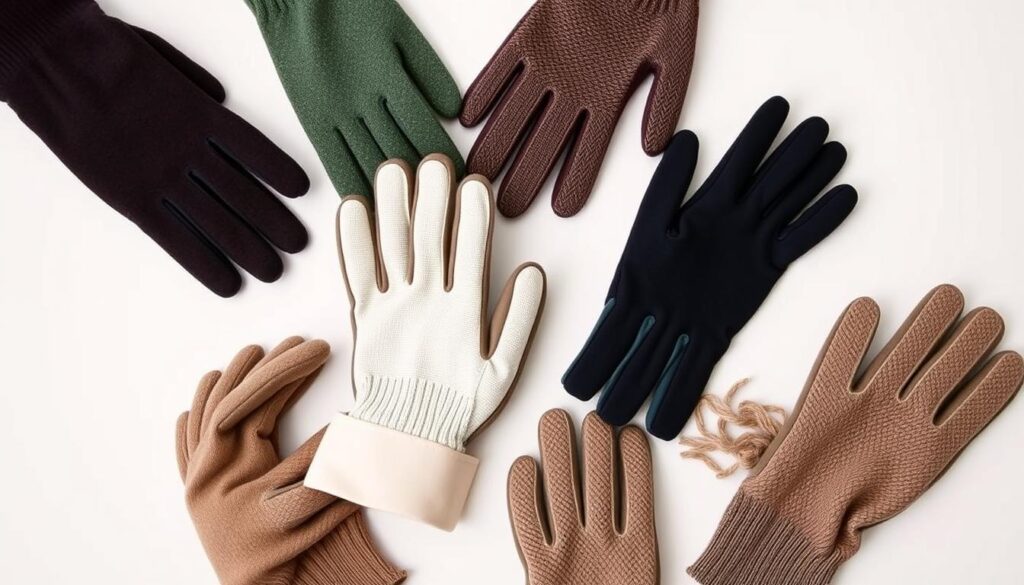
After thoroughly testing and comparing the top garden gloves available in 2025, we’ve found that the best choice depends largely on your specific gardening activities, local climate, and personal preferences. Each model in our lineup offers distinct advantages for different types of gardening enthusiasts.
The Garrett Wade Puncture-Resistant Garden Gloves earn our Editor’s Choice recommendation for their exceptional combination of protection, dexterity, and durability. Their innovative aramid fiber reinforcement provides superior puncture resistance without sacrificing the flexibility needed for precision tasks. These versatile gloves excel across a wide range of gardening activities, making them an excellent primary option for serious gardeners who want one premium pair for most tasks.
For those who frequently work with roses or other thorny plants, the Woheer Leather Thorn Proof Garden Gloves offer unmatched puncture protection with their full-grain cowhide construction and reinforced palm. Their extended gauntlet provides valuable wrist protection, while their durable construction ensures long-term value despite the premium price point.
Gardeners who prioritize dexterity for delicate tasks should strongly consider the Foxgloves Garden Gloves, which provide a second-skin feel and exceptional tactile sensitivity. Their touchscreen compatibility adds modern convenience, while their breathable construction excels in warmer conditions.
For wet condition gardening, the Wells Lamont Hydra Leather Garden Gloves stand out with their HydraHyde technology that creates an effective moisture barrier while maintaining leather’s natural durability and protection. These versatile gloves perform well across seasons, particularly in spring and fall when moisture management becomes crucial.
Hot weather gardeners will appreciate the Cool Job Garden Gloves with their specialized cooling technology and strategic ventilation that prevent the discomfort of overheated hands. Their nitrile coating provides good grip even in sweaty conditions, while their machine washability accommodates frequent cleaning during intensive summer gardening.
Environmentally conscious gardeners should explore the Pine Tree Garden Gloves, which utilize sustainable bamboo fiber construction with natural antibacterial properties. These eco-friendly gloves balance environmental responsibility with practical functionality through their latex-coated palms and breathable design.
For those who battle particularly aggressive thorny plants, the Magid Handmaster Extra Long Garden Gloves provide unmatched forearm protection with their 18-inch gauntlet. These specialized gloves excel for specific tasks like rose pruning or blackberry management, though they may prove excessive for general gardening duties.
Many serious gardeners find that maintaining multiple pairs for different tasks and conditions provides the best overall hand protection strategy. A comprehensive collection might include puncture-resistant gloves for thorny plants, high-dexterity gloves for delicate work, and waterproof options for wet conditions. This approach ensures you always have the optimal protection for every gardening challenge while extending the lifespan of each specialized pair.
Whichever garden gloves you select from our 2025 lineup, proper maintenance significantly extends their useful life. Follow our care guidelines for your specific glove materials, inspect regularly for damage, and address minor issues promptly to maximize the value of your garden glove investment.
Ready to Upgrade Your Garden Gloves?
Choose from our top-rated garden gloves and experience the perfect combination of protection, comfort, and durability for your gardening needs.


